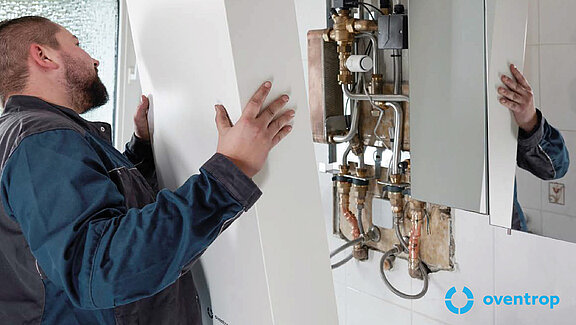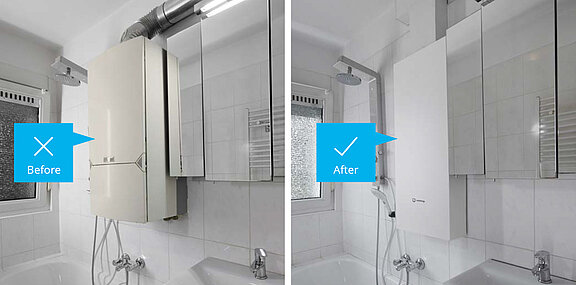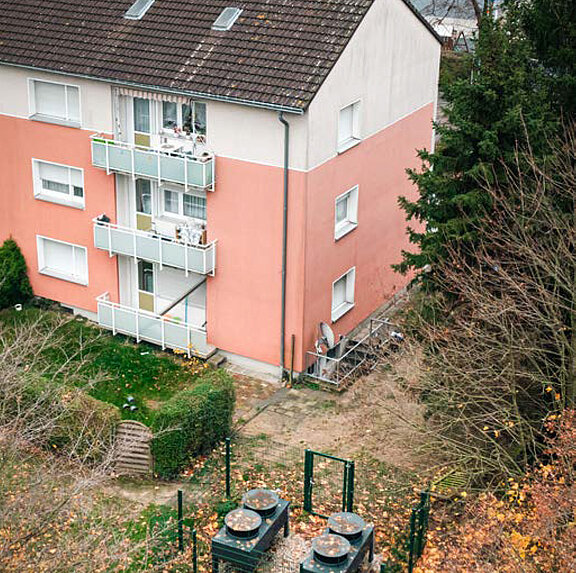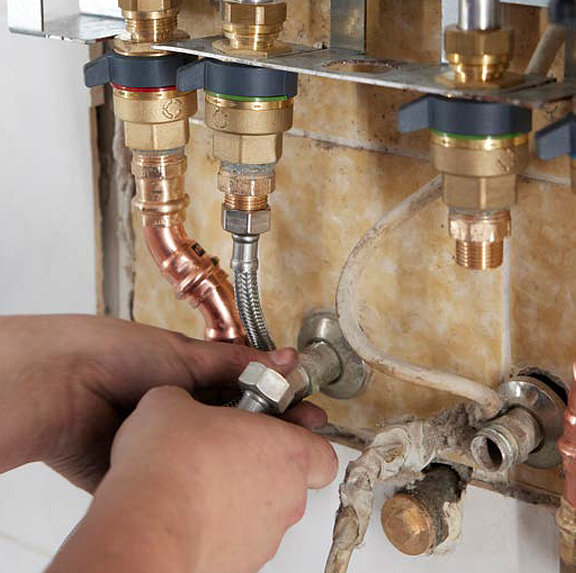
Modernise existing buildings, achieve climate targets
The energy efficiency of buildings plays a key role in achieving climate targets. In Germany, buildings are responsible for around 35% of final energy consumption and cause around a third of CO2 emissions. This is partly due to the heating technology used. There are still around 4 million gas-fired floor heating systems in use across the country.
These need to be replaced by sustainable energy sources, preferably in conjunction with modern home stations. The housing company VIVAWEST relies on the Regudis W-HTE GT home station from Oventrop for this purpose - for example in a housing estate with six apartment blocks in Moers.
In order to achieve the ambitious climate targets set by the German government, the ecological footprint of the German building stock urgently needs to be improved. One of the levers for this is the decarbonisation of heating systems in existing buildings. Carbon-based heating systems must be replaced with new, more environmentally friendly energy sources - this is the aim of the Building Energy Act (GEG). The housing company VIVAWEST, one of the largest portfolio holders in North Rhine-Westphalia with 120,000 flats, set itself extensive sustainability targets back in 2016, which have been repeatedly adjusted over the years. "In addition to creating a climate-neutral building stock by 2045, one of these goals is to test innovative products, processes and technologies for more environmentally friendly property management," says Mathias Ruß, Project Manager at VIVAWEST.
Simple replacement, high efficiency
The most recent example: a housing estate with 46 residential units in six apartment blocks in Moers. The old gas boilers were replaced with a central heating system with heat pumps by the end of 2023 while the buildings were occupied. The new Regudis W-HTE GT flat stations from Oventrop are used for decentralised, apartment-by-apartment heat distribution for space heating and domestic hot water. "All over Germany, as in the housing estate in Moers, there are inefficient gas-fired floor heating systems that need to be replaced by climate-friendly solutions. The home station was developed precisely for this application," explains Michael Ricke, Key Account Manager Region North/West at Oventrop. The home stations are an efficient solution for existing buildings to supply flats with heat and hot water. Compared to centralised hot water heating, which has to be operated at high temperatures all year round in apartment buildings, the home stations can be operated at a lower temperature level thanks to decentralised DHW heating. This supports the efficient operation of heat pumps. "The efficiency is fantastic. With heating water at 56 °C, the system can heat hot water up to 55 °C," praises Ruß.
Maximum hygiene standards
Home stations also ensure hygienically perfect hot water preparation. The home stations generate hot drinking water decentrally via a highly efficient heat exchanger consisting of thin, finely structured stainless steel plates: Using the counterflow principle, cold drinking water and the heating flow are channelled past each other so that hot drinking water is only provided exactly when it is needed. This enables hygiene standards that cannot be achieved with a centralised solution - and they pay off: As the home stations only heat the drinking water when it is needed, there is no need to keep hot drinking water on hand. This eliminates the cost-intensive requirement for regular legionella testing throughout the building.
Simple hydronic balancing
Hydronic balancing is also considerably simplified by the home stations - for example, thanks to an integrated multifunctional valve. "Every flat in Moers has a differential pressure regulator, which makes it possible to carry out hydronic balancing quickly and effectively at the radiator without the need for balancing valves in the distribution system," says Ricke. This is a not insignificant advantage, as hydronic balancing has been a legal requirement for every newly installed heating system since 1 October 2024, regardless of the energy source, in accordance with Section 60c of the GEG.
Existing connections can be used
The Regudis W-HTE GT unfolds its full potential in the area of modernisation not least during installation. As the connections of the home stations are arranged in such a way that the existing connections can be reused, the experienced fitters were able to carry out the installation quickly. The new supply lines were routed through the old chimney shafts and connected to the home stations from above. The outgoing pipework for the flat is located at the bottom. In addition, the home stations with a width of 440 millimetres fit exactly into the space of the old gas boilers - and the precisely fitting cover optimally covers the home stations and the pipework.

Any boiler can be replaced
The project in Moers shows that any boiler can be replaced: Any boiler can be replaced - preferably with a home station. In the case of the Regudis W-HTE GT, it was even possible to replace it while the building was occupied and during the heating period. It is these practical, efficient and quickly realisable solutions that can lead the German building stock into a climate-neutral future.
Smarter planning, efficient refurbishment – heating modernisation with free Oventrop data set
We support LINEAR users in implementing these efficient solutions with the free Oventrop product data set. This is available in the LINEAR Installation Center.


